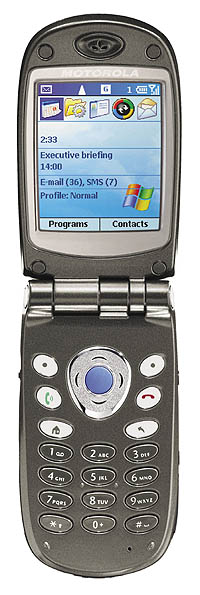The Microsoft Smartphone is finally here. It was supposed to be available over two years ago, but there were a number of changes and delays. But it is here now and you can get one at your local wireless store. What is a Microsoft Smartphone?
 First of all, these or not actually Microsoft smartphones. They are advanced handsets that run what is officially termed "Microsoft Windows Mobile Software for Smartphone." Two of them are currently available in the US, the Samsung SCH-i600 and the Motorola MPx200 which we had a chance to use and review for a few weeks.
First of all, these or not actually Microsoft smartphones. They are advanced handsets that run what is officially termed "Microsoft Windows Mobile Software for Smartphone." Two of them are currently available in the US, the Samsung SCH-i600 and the Motorola MPx200 which we had a chance to use and review for a few weeks.
So what is a Windows Mobile-based smartphone? If you have one of the newer handsets from Nokia or Sony Ericsson you know that they all now have their own graphical user interfaces, applications, utilities, games, internet access and PC connectivity. But who does all of that better than Microsoft? No one except for Apple, and they don't make phones. So a Windows Mobile-based smartphone is simply a phone with a Microsoft-class user interface. However, unlike Pocket PCs with the Windows Mobile Pocket PC Phone Edition software, these are full-featured phones and not little Pocket PCs with a phone grafted on. They look like phones and work like phones. The TFT display of the Motorola MPx200 measures just 2.2 inches diagonally and the resolution is only 176 x 220 pixels. The whole thing has a footprint of just 3.4 x 1.8 inches and is an inch thick. It weighs 4.2 ounces and makes my Sony T616 phone look huge and its display dinky.
Unlike a Pocket PC phone and even some current smartphones, Windows Mobile-based units do neither have a touchscreen nor a joystick. They are designed for one-handed operation. To accomplish that, Microsoft created a user interface where everything is done by pushing buttons. There are no pop-ups, pulldowns or overlapping windows. Most of the time you use just your thumb to operate the phone.
Those used to Pocket PCs will find a lot of familiar elements. The program list is still there and it contains many of the same entries as on a Pocket PC: Inbox, Contacts, Calendar, Internet Explorer, ActiveSync, File Manager, Tasks, Voice Recorder, MSN Messenger, Favorites, Calculator, and even Games. In addition, there are some phone and service-specific items. My MPx200 used AT&T Wireless and had mMode and OfficeOnline, two AT&T services. Like all good phones, it has Speed Dial, Call History, and numerous settings. And since the MPx200 uses GSM and GPRS, there is also a SIM Manager. Missing, since this is a phone, are the Word and Excel Pocket Office apps. Nine items fit onto a menu and you can select them by either scrolling down and pressing enter or simply punching in the number. And the customizable Home screen is just terrific.
There are similarities to Pocket PCs on the hardware side. The 32MB of onboard RAM is divided into storage and program space. A SD Card slot can be used to store additional data. Audio output is in stereo. And the display is an excellent TFT LCD with 65k color capability. Even very small fonts are perfectly legible on this fine display. It is too bad that the system font itself can only be toggled between normal and large, and not the much smaller font the browser uses.
One of the strongest selling points of Windows Mobile-based smartphones is Outlook integration. While most of the current advanced phones can exchange data with PC PIMs, none of the others comes close to Microsoft's own. Synchronization works exactly like it does with a Pocket PC. If you have ActiveSync 3.7 on your PC or notebook you can sync with a Windows Mobile-based smartphone via IR, USB, or even continually through the air with Microsoft Exchange Server with Mobile Information Server and Exchange 2003.
Entering data can be a frustrating experience for those used to a PDA. Without Transcriber or even a popup keyboard data entry is limited to the numeric keypad and multi-press. T9 predictive and voice recognition may be supported on some hardware. And there are some picklists.
Since Windows Mobile-based smartphones have a true browser you can access any website out there, in theory at least. In practice, you better stay with specially formatted sites as the phone and tiny screen quickly become overwhelmed by standard webpages.
Email can be done in a number of ways. The Inbox lets you easily set up direct access to your POP3 or IMAP4 mail account. Or you can use AT&T's Office Online for an extra fee.
The included Windows Media Player 8 is downright amazing. It supports MP3 and Microsoft's Windows audio and video formats, WMA and WMV. With a big enough SD Card you can listen to hours of crystal clear stereo music or watch movies.
As a phone, the MPx200 does everything you expect it to: speakerphone, profiles, conference calls, ring tones, and a great integration with the Contacts database.
Personally, I like the Windows Mobile-based smartphone much better that I expected. Microsoft did a super job of adapting the familiar Windows interface and many powerful apps into a phone that's no larger than we expect phones to be these days. -
Conrad Blickenstorfer is editor-in-chief of RuggedPCReview.com. He can be contacted at cb@pencomputing.com.



